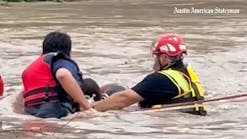GIS May Be Key to the Future of Emergency Response
No one can predict when an emergency will occur or what shape it will take. It could look like a hurricane causing widespread power outages and downed trees, or it could be a chemical fire that takes place down the road from a hospital housing hundreds of at-risk patients. The emergency could even be an instance of civil unrest disrupting traffic patterns and threatening public safety. The way in which municipalities and first responders react to and proactively plan for each of these emergencies may be different, but the information required to effectively manage them is similar: it needs to be accurate, current, and easily accessible.
Centralizing a municipality’s spatial data, tables, and other supporting information, a Geographic Information System (GIS) provides an ideal mechanism for storing, managing, and sharing critical data related to people, infrastructure, and the environment. This technology can be used to respond to and proactively plan for emergencies by assembling area specific and community-derived data. GIS can take the form of desktop map applications, web maps, and mobile applications, all deployed with the collective goal of distributing live information to those who need it in real-time. While traditional GIS is often compared to a simple digital map, it is much more than that. GIS incorporates critical spatial data with related information, documentation, operational workflows, reporting, and the ability to communicate with the public.
Before an anticipated emergency, response teams can begin to prepare assets and resources and identify risks using GIS as a tool. If a storm is on its way and power outages are imminent, for example, it may make sense to prioritize tracking and monitoring vulnerable trees. Collateral damage may even be avoided altogether as vulnerable assets can be strategically reinforced and resources prepped prior, eliminating panic amongst the public. This technology provides a significant advantage to all involved in emergency preparedness and response as the data needed to create an effective strategy is in one place ready to be analyzed for the current need.
There are, however, emergencies that are not anticipated and therefore do not have a specific, direct plan of response. In this case, it is critical that all team members, regardless of physical location or role, have access to the same information to ensure everyone is actively reviewing and analyzing the same details of an evolving situation. The nucleus of a GIS is a centralized database of location-based information in a single data repository.
When designed and deployed for effective communication and data distribution, GIS is accessible, both in office and in the field via cloud-based mobile apps. As various team members record valuable information, the data is synchronized with the parent online database, ensuring a dynamic exchange of critical information between users. In this way, a cloud-based GIS provides a singular source of real-time information and analysis for everyone involved. Additionally, during large emergency response operations, departments can share vital information via public data portals. Using a cloud-based platform, data can be shared with the public within moments of its collection.
During the COVID-19 pandemic, the world became intimately familiar with the superbly designed, Johns Hopkins University Coronavirus Dashboard. At the core of this powerful tool is GIS data. In the same way that this dashboard shared valuable information and statistics with the world, a locally-hosted dashboard can convey key metrics and important instructions for civilians via a GIS map-centric portal. Critical location-based data contained in GIS often includes mapped evacuation routes, wildfire perimeters, traditional, and pop-up first-aid facilities. The sharing of resources will improve the lines of communication between the public and first responders, making emergency response more effective and efficient.
Perhaps the most reliable form of GIS data creation is in-field data collection. Though developing data by interpreting engineering plans or by incorporating historical data is quite valuable, having a user’s eyes on a particular asset, facility, or land mass will provide the best account of a particular situation. As such, agencies have benefited greatly by deploying field teams to inventory and assess municipal assets. This is performed both prior to, and after storms, civil unrest, and other disasters. Pre- and post-event field observations can be compared and analyzed to reveal the areas in greatest need of recovery assistance. For first responders in particular, real-time data can make all the difference in their efforts. Historical data alone could leave vital information out of their reach.
A secondary benefit to developing map data within a GIS is the ability to use that real-time data during emergency dispatch. Because GIS data is created in real-world coordinates, it can be output to a variety of geospatial formats. The most common dispatch software products used by emergency responders include optional map display modules. These map modules can consume and visualize GIS data, thereby enhancing the call-takers ability to gain an accurate picture of an emergency’s location and surroundings.
While GIS is an incredibly powerful set of software and analysis tools, one of the most common byproducts is paper maps. Found in almost any firehouse is a jurisdictional response area map depicting the local communities served by the department. Often, however, these maps are simply road maps that have taken on new roles with hand-marked hydrants, nursing homes, and circled and highlighted locations of other sensitive receptors. By centralizing critical information, GIS can be leveraged to produce a wide variety of useful map products that may take the shape of large wall maps that detail the entire service area, or printed truck books that break down the response area into focused, detailed pages within a binder. Common maps developed for fire departments include department-wide hydrant maps, hazardous material locations, school zones, evacuation routes, and assisted living complexes. Regardless of whether it is mounted on the wall, or in a book that is kept in the trucks, having this information depicted in a clear map at their fingertips during an emergency saves time when seconds count.
The importance of properly training staff on new technology and the development of an improved comprehensive emergency management plan cannot be underestimated. By embracing the advantage GIS provides, fallout can be mitigated and those planning for and responding to emergencies can enter situations with increased confidence. H2M architects + engineers is prepared to use GIS and other programs and devices to help municipalities, and in doing so, support first responders by ensuring the information they have access to is reliable and up to date. GIS comprises just one part of a municipality’s emergency plan, but it is a critical foundation.

Dennis A. Ross
Dennis Ross, AIA, is a Technical Advisor and past Emergency Services Market Director at H2M architects + engineers. Previously, he was a founder and co-owner of a nationally recognized, award-winning firm exclusively dedicated to the design of emergency response facilities across North America. He has over 40 years of focused experience in construction and development, which allows him to assess projects from multiple points of view.
He is NCARB certified; a member of the American Institute of Architects, National Fire Protection Association (NFPA), and the International Code Council; licensed in 14 states; and an honorary member of the Kingston Fire Department. His expertise in public forums, project management, land use, budgeting, construction and focus on solutions to difficult problems has enabled him to knowledgeably write and speak on a variety of emergency services station design issues. Dennis has authored many articles and presented at even more conferences. In 2001, he received the Business Council of New York State’s and National Federation of Independent Business’ annual award for “New York State Small Business Advocate of the Year.”
Dennis is currently serving on the NFPA Technical Committee on “Emergency Responders Occupational Health,” which is tasked with developing a new Standard for Contamination Control, NFPA 1585. Dennis led the task group for Chapter 5, Emergency Services Organization Facilities. In 2022, he was appointed to the NFPA - Architects, Engineers, Building Officials (AEBO) commitee as an Executive Board Member.

Christopher Kobos
Chris Kobos, PMP, GISP, is the Director of GIS Services at H2M architects + engineers. As a GIS professional with more than 20 years of experience, he works directly with clients to provide technical guidance and project management services for municipal, utility, public safety, and private sector GIS projects. He oversees and offers technical direction to a group of GIS analysts and specialists and is responsible for the continuous development and maintenance of technical competencies with the industry-standard software and cloud platforms required for successful solution delivery. His extensive experience serving emergency service clients and all levels of municipal governments lends itself to a unique perspective on the client business needs and the most appropriate procedures for delivering high quality, effective consulting products and services.







